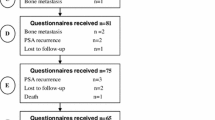Purpose:
To prospectively assess quality of life (QoL) in patients receiving conformal radiation therapy (CRT) for prostate cancer.
Patients and Methods:
78 men with definitive CRT for prostate cancer were entered into the study. Patients were assessed before CRT, at 40 and 60 Gy, and 2, 12 and 24 months after the end of treatment. QoL was assessed using the EORTC Quality of Life Questionnaire C30 and the prostate module PR25. Changes in mean QoL scores with time of ≥ 10 points were considered clinically relevant.
Results:
Global QoL did not change statistically significant during CRT and was slightly above baseline levels during follow-up. CRT had a statistically significant negative short-term impact on role functioning, fatigue, and PR25 urinary symptoms. The scores recovered within 2 months to 1 year after CRT. Emotional functioning and social functioning scores slightly increased during and after CRT. Role functioning decreased by > 10 points at 60 Gy and urinary symptoms decreased by > 10 points at 40 and 60 Gy. All other differences were < 10 points. A high number of concomitant diseases and having no children were negative pretreatment predictors for long-term global QoL.
Conclusion:
Definitive CRT for prostate cancer does not compromise global QoL during therapy and up to 2 years after treatment. It has a limited negative effect on role functioning, urinary symptoms and, to a lesser extent, on fatigue with restitution within 2 months to 1 year after treatment.
Ziel:
Prospektive Untersuchung der gesundheitsassoziierten Lebensqualität bei Patienten mit konformaler Strahlentherapie des Prostatakarzinoms.
Patienten und Methodik:
78 Patienten mit definitiver konformaler Strahlentherapie eines Prostatakarzinoms wurden vor, während (40 Gy, 60 Gy) sowie 2, 12 und 24 Monate nach Therapie untersucht. Zur Evaluation der Lebensqualität wurden der EORTC Quality of Life Questionnaire C30 und das Prostatamodul PR25 verwendet. Veränderungen ≥ 10 Scorepunkte wurden als klinisch signifikant eingestuft.
Ergebnisse:
Die globale Lebensqualität änderte sich während der Strahlentherapie nicht statistisch signifikant und lag im Beobachtungszeitraum nach Behandlung etwas oberhalb der Ausgangswerte. Es fand sich ein kurzfristiger, statistisch signifikanter negativer Effekt auf Rollenfunktion, Fatigue und urologische Symptome. Die betroffenen Scores erholten sich innerhalb von 8 Wochen bis 1 Jahr nach der Strahlentherapie. Der emotionale und der soziale Funktionsscore stiegen während und nach Therapie etwas an. Bei 60 Gy lag die Rollenfunktion um > 10 Punkte unterhalb des Ausgangswerts, und bei 40 und 60 Gy stieg der Score für urologische Symptome um > 10 Punkte über den Ausgangswert an. Alle anderen Veränderungen waren < 10 Scorepunkte. Eine höhere Anzahl an Begleiterkrankungen und Kinderlosigkeit waren negative prätherapeutische Prädiktoren für die globale Lebensqualität nach 2 Jahren.
Schlussfolgerung:
Eine definitive konformale Strahlentherapie des Prostatakarzinoms wirkt sich nicht negativ auf die globale Lebensqualität während und bis zu 2 Jahren nach Behandlung aus. Sie hat einen zeitlich limitierten negativen Effekt auf die Rollenfunktion und die urologischen Symptome und in einem geringeren Ausmaß auf die Fatigue.
Similar content being viewed by others
References
Aaronson NK, Ahmedzai S, Bergman B, et al. The European Organization for Research and Treatment of Cancer QLQ-C30: a quality-of-life instrument for use in international clinical trials in oncology. J Natl Cancer Inst 1993;85:365–76.
Beard CJ, Propert KJ, Rieker PP, et al. Complications after treatment with external-beam irradiation in early-stage prostate cancer patients: a prospective multiinstitutional outcomes study. J Clin Oncol 1997;15:223–9.
Bohrer M, Schroder P, Welzel G, et al. Reduced rectal toxicity with ultrasound-based image guided radiotherapy using BAT (B-mode acquisition and targeting system) for prostate cancer. Strahlenther Onkol 2008;184:674–8.
Danjoux C, Gardner S, Fitch M. Prospective evaluation of fatigue during a course of curative radiotherapy for localised prostate cancer. Support Care Cancer 2007;15:1169–76.
Galalae RM, Loch T, Riemer B, et al. Health-related quality of life measurement in long-term survivors and outcome following radical radiotherapy for localized prostate cancer. Strahlenther Onkol 2004;180:582–9.
Geinitz H, Zimmermann F, Stoll P, et al. Fatigue, serum cytokine levels and blood cell counts during radiation therapy of patients with breast cancer. Int J Radiat Oncol Biol Phys 2001;51:691–8.
Geinitz H, Zimmermann F, Thamm R, et al. 3-D conformal radiation therapy for prostate cancer in elderly patients. Radiother Oncol 2005;76:27–34.
Geinitz H, Zimmermann F, Thamm R, et al. Late rectal symptoms and quality of life after conformal radiation therapy for prostate cancer. Radiother Oncol 2006;79:341–7.
Glaus A. Fatigue in patients with cancer. Analysis and assessment. Recent Results Cancer Res 1998;145:I–172.
Goldner G, Bombosch V, Geinitz H, et al. Moderate risk-adapted dose escalation with three-dimensional conformal radiotherapy of localized prostate cancer from 70 to 74 Gy. First report on 5-year morbidity and biochemical control from a prospective Austrian-German multicenter phase II trial. Strahlenther Onkol 2010;185:94–100.
Goldner G, Wachter S, Wachter-Gerstner N, et al. Long-term results in three-dimensional conformal radiotherapy of localized prostate cancer at moderate dose (66 Gy). Strahlenther Onkol 2006;182:537–42.
Hickok JT, Roscoe JA, Morrow GR, et al. Frequency, severity, clinical course, and correlates of fatigue in 372 patients during 5 weeks of radiotherapy for cancer. Cancer 2005;104:1772–8.
Hille A, Herrmann MK, Kertesz T, et al. Sodium butyrate enemas in the treatment of acute radiation-induced proctitis in patients with prostate cancer and the impact on late proctitis. A prospective evaluation. Strahlenther Onkol 2008;184:686–92.
Janda M, Gerstner N, Obermair A, et al. Quality of life changes during conformal radiation therapy for prostate carcinoma. Cancer 2000;89:1322–8.
Jenkins VA, Bloomfield DJ, Shilling VM, et al. Does neoadjuvant hormone therapy for early prostate cancer affect cognition? Results from a pilot study. BJU Int 2005;96:48–53.
Korfage I, Essink-Bot ML, Borsboom GJJM, et al. Five-year follow-up of health-related quality of life after primary treatment of localized prostate cancer. Int J Cancer 2005;116:291–6.
Kouloulias VE, Kouvaris JR, Pissakas G, et al. A phase II randomized study of topical intrarectal administration of amifostine for the prevention of acute radiation-induced rectal toxicity. Strahlenther Onkol 2004;180:557–62.
Lips I, Dehnad H, Kruger AB, et al. Health-related quality of life in patients with locally advanced prostate cancer after 76 Gy intensity-modulated radiotherapy vs. 70 Gy conformal radiotherapy in a prospective longitudinal study. Int J Radiat Oncol Biol Phys 2007;69:656–61.
Lips IM, van Gils CH, van der Heide UA, et al. Health-related quality of life 3 years after high-dose intensity-modulated radiotherapy with gold fiducial marker-based position verification. BJU Int 2009;103:762–7.
Mavroidis P, al-Abany M, Helgason AR, et al. Dose-response relations for anal sphincter regarding fecal leakage and blood or phlegm in stools after radiotherapy for prostate cancer. Strahlenther Onkol 2005;181:293–306.
Osoba D, Bezjak A, Brundage M, et al. Analysis and interpretation of health-related quality-of-life data from clinical trials: basic approach of the National Cancer Institute of Canada Clinical Trials Group. Eur J Cancer 2005;41:280–7.
Peeters ST, Heemsbergen WD, van Putten WLJ, et al. Acute and late complications after radiotherapy for prostate cancer: results of a multicenter randomized trial comparing 68 to 78 Gy. Int J Radiat Oncol Biol Phys 2005;61:1019–34.
Pinkawa M, Fischedick K, Asadpour B, et al. Health-related quality of life after adjuvant and salvage postoperative radiotherapy for prostate cancer — a prospective analysis. Radiother Oncol 2008;88:135–9.
Pinkawa M, Piroth MD, Asadpour B, et al. Neoadjuvant hormonal therapy and external-beam radiotherapy versus external-beam irradiation alone for prostate cancer. A quality-of-life analysis. Strahlenther Onkol 2010;185:101–8.
Roach M III, Hanks G, Thames H Jr, et al. Defining biochemical failure following radiotherapy with or without hormonal therapy in men with clinically clinically localized prostate cancer: recommendations of the RTOG-ASTRO Phoenix Consensus Conference. Int J Radiat Oncol Biol Phys 2006;65:965–74.
Sloan JA, Frost MH, Berzon R, et al. The clinical significance of quality of life assessments in oncology: a summary for clinicians. Support Care Cancer 2006;14:988–98.
Staff I, Salner SA, Bohannon R, et al. Disease-specific symptoms and general quality of life of patients with prostate carcinoma before and after primary three-dimensional conformal radiotherapy. Cancer 2003;98:2335–43.
Stephens RJ, Dearnaley DP, Cowan R, et al. The quality of life of men with locally advanced prostate cancer during neoadjuvant hormone therapy: data from the Medical Research Council RT01 trial (ISRCTN 47772397). BJU Int 2007;99:301–10.
Wachter S, Gerstner N, Dorner D, et al. The influence of a rectal balloon tube as internal immobilization device on variations of volumes and dose-volume histograms during treatment course of conformal radiotherapy for prostate cancer. Int J Radiat Oncol Biol Phys 2002;52:91–100.
Watkins Bruner D, Scott C, Lawton CA, et al. RTOG’s first quality of life study — RTOG 90-20: a phase II trial of external beam radiation with etanidazole for locally advanced prostate cancer. Int J Radiat Oncol Biol Phys 1995;33:901–6.
Weiss W, Horninger W, Forthuber BC, et al. Single-institution results of primary external-beam radiation for the treatment of T1-T3 prostate cancer. Strahlenther Onkol 2007;183:321–6.
Windsor PM, Nicol KF, Potter J. A randomized, controlled trial of aerobic exercise for treatment-related fatigue in men receiving radical external beam radiotherapy for localized prostate carcinoma. Cancer 2004;101:550–7.
Wratten C, Kilmurray J, Nash S, et al. Fatigue during breast radiotherapy and its relationship to biological factors. Int J Radiat Oncol Biol Phys 2004;59:160–7.
Author information
Authors and Affiliations
Corresponding author
Additional information
An erratum to this article can be found at http://dx.doi.org/10.1007/s00066-010-7001-6
Rights and permissions
About this article
Cite this article
Geinitz, H., Thamm, R., Scholz, C. et al. Longitudinal Analysis of Quality of Life in Patients Receiving Conformal Radiation Therapy for Prostate Cancer. Strahlenther Onkol 186, 46–52 (2010). https://doi.org/10.1007/s00066-009-2023-7
Received:
Accepted:
Published:
Issue Date:
DOI: https://doi.org/10.1007/s00066-009-2023-7




